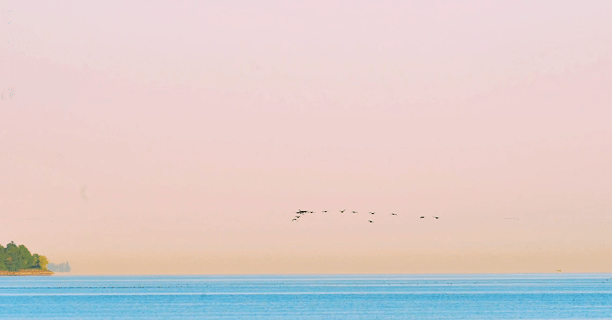The Narrow Thread of Infinity and the Current of Calm
There’s a kind of stillness that sneaks up on me when I stand at the edge of Lake Erie. The noise in my head from the work I’m not creating, the worries of this-that-and-them, the to-do lists, emails, and planning - all of it quiets. My shoulders drop. My breathing slows. It’s as if my body remembers something ancient, something older than thought… because it is.
Science would tell me it’s the amygdala letting its guard down, that almond shaped cluster of neurons deep within the brain’s temporal lobe. The parasympathetic system doing its job, cortisol easing off, the body signaling: you’re safe. I find that comforting, actually. To know there’s an explanation, that biology itself can orchestrate this peace. But understanding it doesn’t make it any less profound. If anything, it makes it more miraculous.
There’s also something else happening, something that science can’t quite touch. Standing before that vast stretch of water and sky feels a bit like standing at an altar, worshipping the grandeur of stillness and presence.
A narrow thread of infinity is the invitation to us all, too often the invitation is ignored.
I often think of the Great Lakes as our quiet answer to the Grand Canyon, grandeur turned sideways. The Grand Canyon stuns by subtraction, by what’s been carved away. Its beauty is exposure: rock, time, gravity all laid bare. People fly across the country to stand at its rim, to feel small in the best possible way, to look down into the Earth’s memory. But here, along our northern horizon, lies a monument just as vast, only in reverse. The Great Lakes are not carved open but filled, immense basins scooped by glaciers and softened by time, now holding twenty percent of the world’s surface fresh water. If they were empty, they would reveal a landscape so immense it could cradle mountain ranges within its basins. Is it just me, or does the moniker great seem inadequate?
Perhaps that’s what makes the Great Lakes miraculous in a different way… they share the Midwest’s quiet humility, content to be extraordinary without needing to announce it. They do not shout their magnificence; they whisper it. They don’t blaze red or unfold in dramatic verticals; they stretch wide and restless, shifting from glass to fury, until sky and water become indistinguishable. They belong to no one and everyone, an endless mirror reflecting what we offer. The horizon becomes a kind of covenant between body and landscape: a narrow thread of infinity that steadies the nervous system, softens the mind, and invites stillness. Standing there, you’re not looking into the past like at the Grand Canyon… you’re looking outward into possibility. Our Great Lake Erie gives you both reflection and escape.
And yet, most of us pass it daily without ceremony. We glance at it between tasks, half-aware that something remarkable lies just beyond the skyline. The Great Lakes don’t demand attention the way deserts and canyons do; they wait. They test our capacity for reverence in the natural wonder of what appears ordinary. You don’t have to travel to the ends of the Earth to stand somewhere truly grand, in Cleveland, you’re already there.
And everyone waves. Every single time.
The Cuyahoga River moves to a rhythm all its own. My favorite summer indulgence is cruising down it on a boat. It feels like stepping into another world just more enclosed, more human than the lake. The pace slows. The engines idle low, and the river takes the lead, guiding you through its bends and history.
Calm and wonder settle in as you drift beneath bridges and past the old industrial walls. It’s not silence exactly, but there’s a particular kind of quiet to it—the kind that hums beneath conversation. You hear the water slap against the hull, the echo of laughter bouncing off steel, the distant whir of a train. The river carries layers of sound and memory at once. You can almost feel the past brushing against the present, like looking through time at the remnants of what built the city, brick by brick, spark by spark.
It’s impossible not to think about what this river once was. The Cuyahoga is famous for what most rivers would rather forget: the day it caught fire. It burned not once, but more than a dozen times—ignited by oil slicks and chemical runoff, the byproduct of a city that had traded reflection for production. In 1969, the blaze that finally drew national attention lasted less than half an hour, but it lit a movement. Out of that fire came the Clean Water Act, the Environmental Protection Agency, and a new consciousness about what we do to the places that hold us. The Cuyahoga became both cautionary tale and catalyst, proof that even a river can be reborn.
And maybe that’s why there’s something almost sacred about being on it now. Paddle boarders glide by, rowers move in perfect rhythm, families wave from pontoon decks. Even the freighters—massive and improbable, like skyscrapers turned on their side, slide through the channel with the grace of something that knows its own strength. It’s an odd communion: industry and leisure, stillness and motion, people from every walk of life brought into a kind of shared rhythm.
And everyone waves. Every single time.
It’s the unspoken rule of the river. You wave at strangers. You acknowledge each other. Can you imagine doing that at a stoplight? Turning to the driver next to you, making eye contact, and waving? You’d feel ridiculous. You’d probably make them nervous. These days, waving at the wrong person could land you on TikTok with a million views and no context. But on the river, it’s different. On the river, it’s part of the cultural current. It’s connection in its simplest form—fleeting, sincere, and grounding.
Maybe it’s because, on the river, history itself feels present. The same water that once burned now reflects the sky. The same current that carried oil now carries laughter, music, and recreation. That is a reason to wave—because somewhere deep down, we know what it means for something once written off to come back to life.
A River Scene - NA
We are the stewards of the North Coast
It still amazes me that so few people realize how rare this is. Roughly a third of Americans live near a coast or one of the Great Lakes, but only a tiny fraction actually see a horizon like this regularly.
Cuyahoga County has about thirty miles of shoreline. Ninety percent of it is private or blocked by development. That leaves less than three miles of truly public access… for over a million people. One or two percent of us can walk to this view.
And yet this is the United States’ only north coast. The Great Lakes are the largest group of freshwater lakes on Earth, and we’re sitting on its edge. Cleveland, often dismissed or overlooked, holds one of the most extraordinary natural wonders in the country. We should treat it that way. Protect it. Celebrate it. Design with it in mind.
Because an open horizon is more than a view. It’s an act of generosity. It gives the mind space to rest. It gives the body permission to breathe.
Stewards of the North Coast
What We Measure, What We Miss
We count jobs, revenue, visitors, cranes on skylines. But we don’t count heart rates, or calm, or connection. We don’t measure how many people left the lake feeling lighter than when they arrived or connect the impact of this on wellbeing, productivity, crime rates, healthcare costs, etc.
But maybe we should. Maybe that’s where the real value lies.
When I look out across Lake Erie at sunset, I don’t just see water and light. I see the perfect intersection of what I can understand and what I never will. The physics of reflection, the neurochemistry of calm—and something else, something wordless that still feels like prayer.
And maybe that’s the point.
Perhaps both can be true.
Wednesday, October 29th 2025
I’m opening the studio for the creative conversation series of The Alexander Westdale Forum. The title of this conversation: The Great and The Crooked, joined by Cleveland historians and experts from Teaching Cleveland we’ll be focused on Cleveland’s waterfront and waterways… the great Lake Erie and the crooked Cuyahoga River. Join us as we dive into their history, explore their future, and what our role and responsibilities are. This isn’t a history lecture or a talk on economic development, it’s an engaging conversation of culture, art, rhythm, psychology, merged with history and economic development. Special guest contributors to be announced leading up to the event will include people like artists, psychologists, community leaders, and enthusiasts.
Check it out, get your tickets. We’re excited for you to join us.
One more thing… I could use some help with this. Maybe you want to be a part of making it happen?
In the works is a concert series. Imagine something in the spirit of NPR’s Tiny Desk Concerts but performed and recorded live in my studio’s acoustically treated immersive installation Surrender and Smile. It’s not just about listening. It’s about being surrounded, with color, light, and sound stitched together into one experience.
This is happening, it’s a matter of time and resources. There are opportunities for you to support my creative events beyond purchasing artwork and tickets. I think it would be so neat to have local businesses, organizations, or creative champions support the arts by sponsoring this concert series. Contact me for details if this interests you.
Surrender & Smile - Immersive installation
This is just the beginning.
The studio is open most days (artist hours folks), you can pop-in, but I suggest you schedule a visit.






